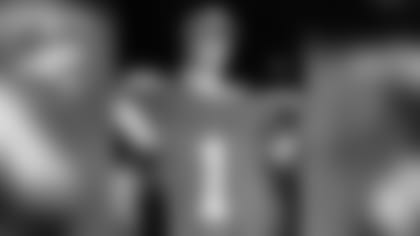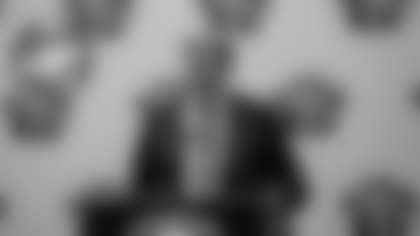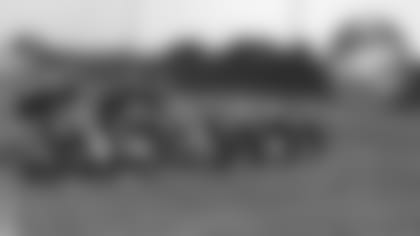Since 1947, the year Curly Lambeau abandoned his Notre Dame Box offense that he learned from Knute Rockne and switched to what he called a V-formation and peddled it as a variation of the T, the Packers have drafted nine quarterbacks in the first round.
In Lambeau's V, the center could still snap the ball to any of three players – the quarterback, the left halfback or the fullback – and for that reason some of Lambeau's players insisted the offense wasn't much different than his outdated Box. But the quarterback received most of the snaps and handled all the passing so it was at least an adaptation of the T. In 1950, the Packers completed the conversion under first-year coach Gene Ronzani, who had learned the T as a quarterback and assistant coach for the Chicago Bears, the team that introduced it to the NFL.
The first NFL Draft was held in 1936 and over the next 11 years, Lambeau's best pick was Cecil Isbell, who played left halfback in his Box, but easily could have been a T-quarterback and ranks as the best passer the Packers have ever drafted No. 1 except for Aaron Rodgers.
In the 73 drafts since Lambeau's switch to the V, here's a look at what dictated the Packers' selection of those nine quarterbacks and the result.
1947: Ernie Case, UCLA – The Packers drafted Case with the sixth overall pick on Dec. 16, 1946, but the selection wasn't disclosed by Lambeau until 11 days later when he was in Los Angeles to scout Case in the Rose Bowl. In fact, with all teams trying to keep their selections a secret because of the competition for players with the upstart All-America Football Conference, the Packers were the first team to announce their entire list of choices, but not until late January.
Case, a 26-year-old left-handed passer who had served as a pilot in World War II, led UCLA to its first unbeaten, untied regular season. Although Lambeau watched Case and his team lose to Illinois, 45-14, in the Rose Bowl, while sitting in the press box next to legendary sportswriter Grantland Rice, he announced less than two weeks later he was switching to the V partly because of Case, who played in a T at UCLA. "Ernie really can throw the ball," said Lambeau. However, in mid-February, Case rejected the cash-strapped Packers' offer and signed with the Baltimore Colts of the AAFC, one day after Isbell had been named their coach. As a rookie, Case, who stood 5-foot-10 and weighed 170 pounds, injured his left shoulder and played mostly defense. He was released, signed by San Francisco and cut after he injured his back in camp in 1948.
1948: Jug Girard, Wisconsin – A native of Marinette, Wis., Girard was a triple-threat left halfback in coach Harry Stuhldreher's Notre Dame Box at the University of Wisconsin and Lambeau, seeing him as an ideal fit for his V, grabbed him with the seventh overall choice. Stuhldreher, one of Rockne's "Four Horsemen" in the 1920s, coached at Wisconsin from 1936-48 and had taken full advantage of Girard's talents as a runner-passer, punter and defensive back.
Lambeau, who valued versatility above all else in his Box offense, won a bidding war over the AAFC New York Yankees to sign Girard and then played him mostly at halfback as a rookie before moving him to quarterback in 1949. Girard shared the position with Jack Jacobs and Stan Heath, but completed only 35.4 percent of his passes in a disastrous 2-10 season. "Girard was a hell of a halfback," said backfield coach Bob Snyder. "Curly is the guy who assigned him as a quarterback. He tried to play the position, a great kid, a hell of an athlete, but he could throw the ball and miss the damn ground."
Moved back to halfback by Ronzani in 1950 and then traded to Detroit in 1952, Girard played five years with the Lions and on two NFL championship teams before finishing his career with Pittsburgh in 1957. Girard's athletic skills also extended to baseball where he led the minor-league Wisconsin State League in batting as a two-sport pro in 1949.
1949: Stan Heath, Nevada – A product of Shorewood (Wis.) High School, Heath was first drafted by the Packers in the 25th round in 1948, but the selection was voided. After Heath led the nation in passing the next fall, Lambeau chose him with the fifth overall pick and thought he had finally solved his quarterback problem. "He seems to be a combination of one of our great passers, Cecil Isbell, and the Los Angeles Rams' (Pro Football Hall of Famer) Bob Waterfield," Lambeau gushed within two weeks of the draft.
Heath played one year with the Packers and finished with some of the worst passing numbers in NFL history: 26 completions in 106 attempts, or 24.5 percent, with one touchdown and 14 interceptions. Waived by Ronzani on Aug. 1, 1950, Heath tried out with the Cleveland Browns in 1951, but couldn't pass coach Paul Brown's mental exam. Post-Packers, Heath's pro career consisted of five seasons in the CFL.
1952: Babe Parilli, Kentucky – Although Tobin Rote, drafted in the second round in 1950, had thrown for more than 1,500 yards and rushed for more than 500 in his second season with the Packers, Ronzani grabbed Parilli with the fourth overall selection. Playing for Bear Bryant at Kentucky, Parilli was the consensus All-American quarterback and came highly recommended. Bryant called Parilli "the finest back I've ever coached or seen."
Parilli shared quarterback duties with Rote for two years, then was traded to Cleveland in a six-player swap in 1954, reacquired from the Browns in 1957 in an eight-player trade and then shared quarterback duties with Bart Starr in 1957-58 before being cut by Vince Lombardi in training camp in 1959.
For all his travels, Parilli passed for more than 20,000 yards – or almost as many as Starr – in a 15-year NFL and AFL career, won a Super Bowl ring with the New York Jets as Joe Namath's backup and was inducted into the New England Patriots Hall of Fame in 1993.
1959: Randy Duncan, Iowa – On Dec. 1, 1958, with two games remaining in their dreadful 1-10-1 season, the Packers with Scooter McLean in charge and Jack Vainisi assisting chose Duncan with the No. 1 pick in the draft. The next day, Duncan said, "I don't know whether I'm going to play pro ball." He said he wanted to go to law school and didn't know how he could manage it playing in Green Bay.
In late January, the Packers hired Lombardi as coach and general manager. A night later, he told a banquet in New Jersey that he had convinced the Giants to select Utah quarterback Lee Grosscup with the 10th overall pick. "I rated him the top college passer around," Lombardi said. In February, Duncan signed with the British Columbia Lions of the Canadian Football League for more money than the Packers offered. Duncan played sparingly for the Lions for two years and then spent a season as a backup for the Dallas Texans of the AFL.
1967: Don Horn, San Diego State – The Packers selected Horn with their second of two first-round draft picks and the 25th overall selection in the first common draft following the AFL-NFL merger agreement. Lombardi coached him one year and said of Horn after Super Bowl II, "Destined to be as great as Bart Starr, if not greater."
In 1969, Horn was 4-1 in five starts, while Starr, troubled by shoulder problems, was 4-5. In the final game, Horn set a Packers single-game record by passing for 410 yards in a 45-28 victory over the St. Louis Cardinals. Two years later, Dan Devine traded him to Denver in a deal that yielded John Brockington. Horn played four more years in the NFL, three as a little-used backup.
1972: Jerry Tagge, Nebraska – A star athlete at Green Bay West High School and quarterback of Nebraska's 1971 national championship team, Tagge was the personal pick of Devine with the 11th overall choice. "I knew Jerry wasn't rated too high," Devine said after the draft. "He figured to be about a third- or fourth-round draft choice … It was pretty much my decision."
Tagge lasted three years and finished with a 44.2 passer rating, including 17 interceptions with only three touchdown passes. He had an average arm, was heavy-legged and didn't move well in the pocket, and later admitted he was drinking heavily and anything but focused on his job. Starr cut him in his first training camp and Tagge later played three years in the CFL.
1981: Rich Campbell, California – On the morning of the draft, Starr informed Dick Corrick, his personnel director, that he was taking Campbell with the sixth overall choice, despite Corrick's pleas the night before to draft defensive back Ronnie Lott. When Starr turned the Campbell pick into the league, the Packers' West Coast scout Lloyd Eaton turned to then assistant to the president Bob Harlan and muttered, "That's a bad choice." Harlan asked why. "He can't play," Eaton responded.
When Harlan then asked Eaton why he hadn't spoken up before the pick, he said because Starr wouldn't have listened to him anyway.
In 1982, when Starr hired Bob Schnelker, hoping among other things that he could salvage Campbell's career, his new offensive coordinator told Dawn Bouzeos of WFRV-TV, soon after camp started, "At this point, (Campbell) doesn't show the arm strength it takes to be a fine quarterback in this league. He just can't zip the ball out there." Campbell played in seven games in four years for the Packers, never advancing above third string.
2005: Aaron Rodgers, California – With his first selection in his first draft as general manager, Ted Thompson grabbed Rodgers with the 24th overall pick. Projected as a possibility to be taken No. 1 by San Francisco, Rodgers tortuously waited in the "Green Room" at NFL Draft central until Thompson without hesitation grasped the magnitude of the opportunity. While it wasn't a need, landing in his lap was a highly rated, potential heir apparent to 35-year old Brett Favre, one of the greatest quarterbacks in the history of the game and coming off a season in which he threw for more than 4,000 yards for only the fourth time in his career.
"We really didn't think it was going to happen," Thompson said of Rodgers' free-fall. "It just didn't make sense." But it made perfect sense to Thompson for him to gobble up the most luscious leftover in NFL Draft history. "I just think when you look back five years from now you'll say, 'This was a hell of a pick," said Thompson.
Fifteen years later, Rodgers has won a Super Bowl, two Associated Press MVP awards and was recently named to the NFL's 2010-19 All-Decade Team.
After nine tries and 58 years, the Packers had hit the bull's eye.















